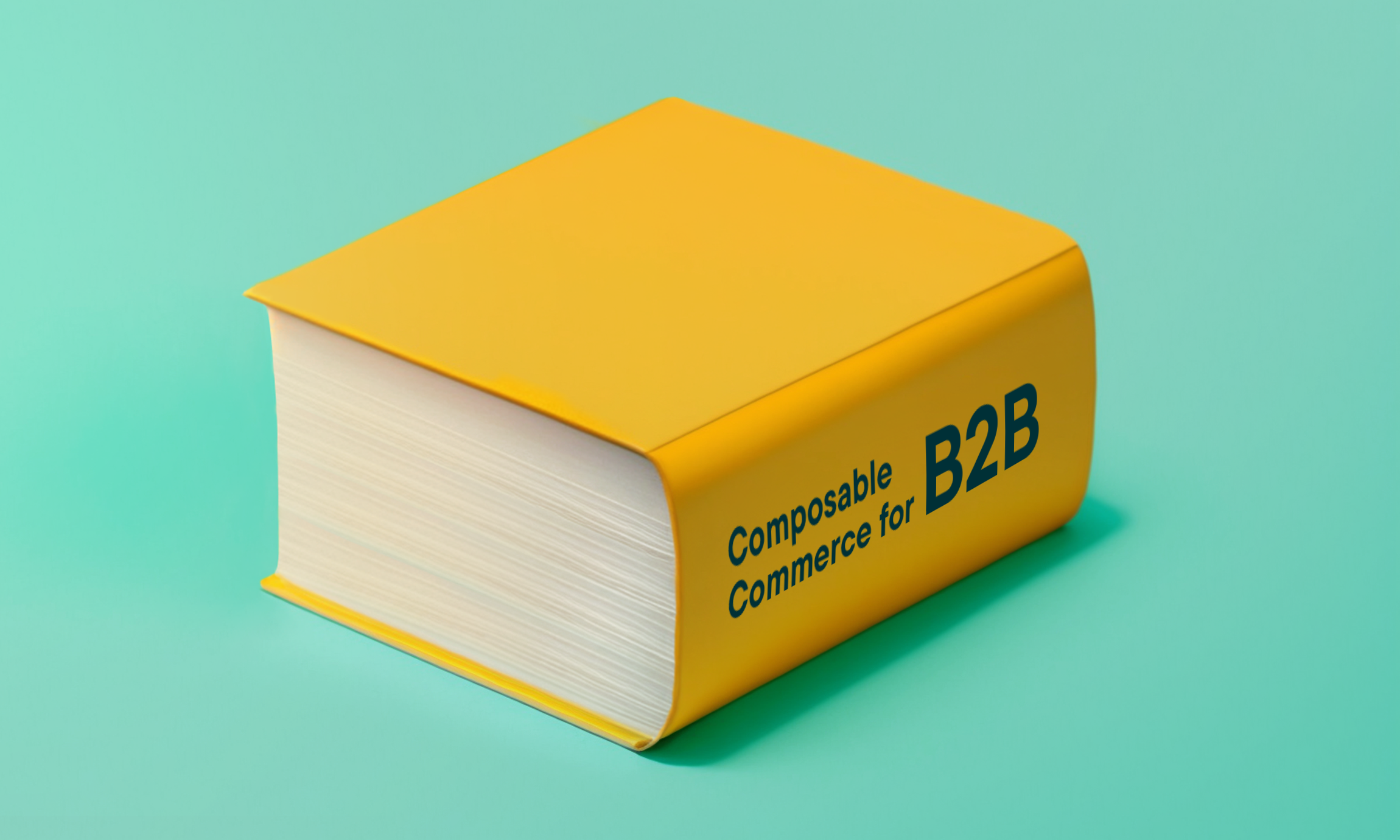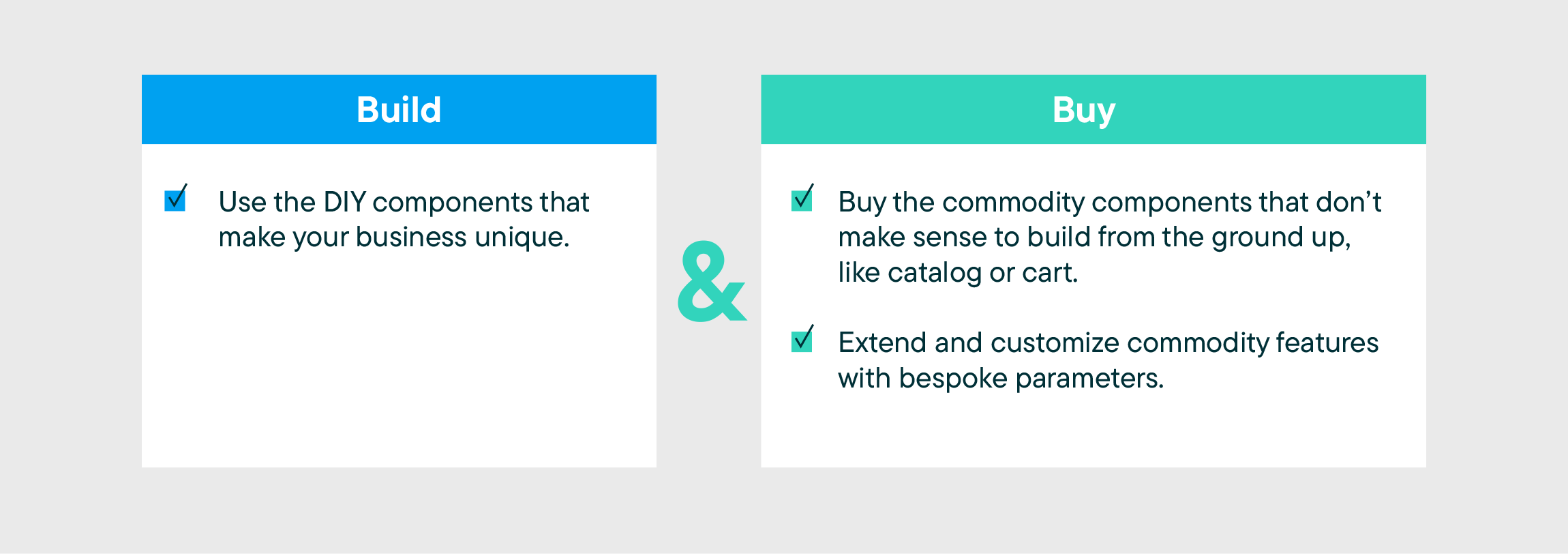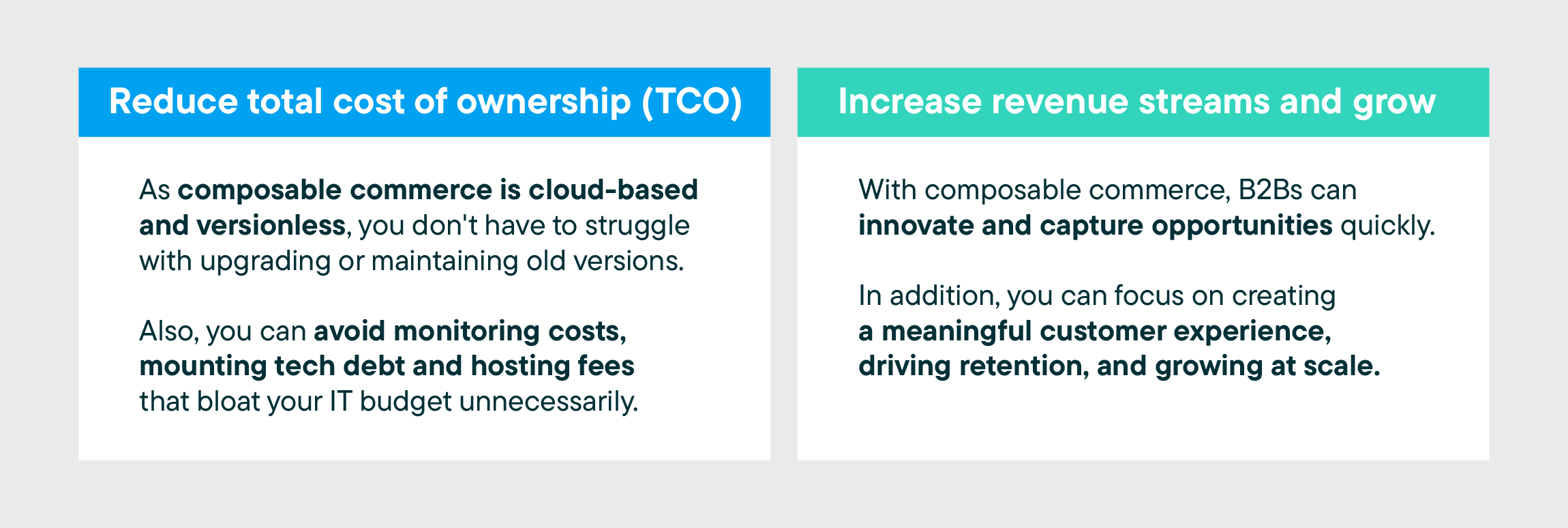If your B2B business is feeling the pressure to invest in a digital transformation ASAP, composable commerce is the way to do it. Do you have questions on benefits, best practices, and how composable impacts TCO and ROI? Get all the answers here.

What does composable commerce mean for B2B?
B2Bs embracing digital commerce no longer need to rely on legacy technology to embark on a digital journey. As a modular development approach, composable commerce enables businesses to leverage best-of-breed building blocks such as checkout, cart and search, and combine them according to their needs.
Composable commerce is particularly significant in B2B as manufacturers, wholesalers and distributors often have complex and unique requirements. That includes, for example, handling large order volumes, managing multiple pricing tiers and integrating with ERP systems. With a composable approach, B2B businesses can add new components without hassle.
Another benefit of a composable stack is the ability for B2Bs to swap or drop components at any time. A real-life example is Dawn Foods, an American global manufacturer of baked goods. The company was able to switch the search component from one provider to another without affecting other systems — or having to deal with vendor lock-in.
Due to their business complexity, many B2Bs prefer to build their own commerce engine in-house. However, this approach may become detrimental to their goals, as businesses tend to outgrow their DIY solutions over time. Instead, B2Bs can pursue a build-and-buy approach with a composable stack:

With a build-and-buy approach, your business can mix third-party applications with in-house-built ones. That way, you can find the ideal mix of “building-AND-buying” that best suits your company’s needs.
Comparing composable commerce vs. homegrownWhat’s the role of MACH™ in implementing composable commerce?
The technologies behind MACH (Microservices-based, API-first, Cloud-native and Headless) comprise the technical backbone that brings composable commerce architecture to life for B2B and B2C companies alike.
B2B companies have adopted MACH to achieve a flexible, agile and easily customizable infrastructure. Normet, an underground mining and tunneling equipment manufacturer, turned to MACH to maximize flexibility and stay competitive, now and in the future.
You need to have the agility to adapt to your changing requirements and needs. I believe that the MACH approach suits that quite well. If we are thinking about 2… 3… 4 years into the future, we need to be prepared in case something changes, for example, in customer behavior or connecting to IoT. If we would have built the system with a traditional monolith eCommerce system, we would have lost that agility for the future. This is why we chose composable architecture.
Director of Digital Services, Normet
What are the benefits of implementing a composable commerce strategy for B2B businesses?
Composable commerce enables businesses to make customer-friendly experiences in B2B a reality. This approach brings six top benefits for B2B sellers:
Adapt to constant change. The pandemic and other macroeconomic factors like the war in Ukraine, the supply chain crisis and rising inflation create challenges for any business. Composable commerce allows B2Bs to adapt easily to new market conditions and customer expectations.
Ability to provide B2B buyers with seamless digital experiences across multiple channels and touchpoints. With a composable stack, B2Bs can create and tweak customer experiences without constraints. It's possible to achieve high-performance digital storefronts, release new features fast and personalize journeys. This is essential as 73% of B2B buyers want a personalized B2C-like experience.
Scale automatically. Scale online capacity automatically with a cloud-native solution, ensuring the performance and speed of your eCommerce.
Automate time-consuming and labor-intensive processes. B2Bs have traditionally been analog when it comes to handling sales and business processes. Composable commerce enables B2Bs to automate and optimize processes like product discovery and quotes generation, as well as recurring orders. As a result, sales teams can focus on more strategic and advisory tasks.
Orchestrate data without friction. Unlock real-time visibility of your data (customer, product, inventory, etc.) and use it to upsell and cross-sell across the customer journey seamlessly.
Innovate faster. Tech teams have more freedom to iterate and experiment with touchpoints and features without incurring downtime. The result? Teams can focus on innovation output, reducing time-to-market for new releases.
Ultimately, composable commerce enables B2Bs to:

How does composable commerce enable B2B businesses to deliver a positive ROI?
Successful companies delivering year-over-year positive ROI have one thing in common: They can innovate rapidly and easily change course. Investing in a composable commerce approach enables B2B companies to recognize opportunities even during times of turbulence. This is why B2Bs can boost revenue streams with composable commerce:
Differentiation. Create customized journeys and offerings to an increasingly demanding B2B buyer base, and stand out from the competition.
Incremental innovation. Accelerate innovation with an expansive API portfolio on a cloud-native solution that lets you increase market share while maintaining performance. You can ramp up promotions and handle increases in traffic and transactions at the same time.
Speed. Deploy new products and features at scale without the constraints of a slow-to-update legacy platform.
Cross-border eCommerce. Expand into new geographies easily, localizing for region, language and currency.
New business models. Expand to new business models such as direct-to-consumer (D2C) with a business-model-agnostic commerce engine, so you can run multiple business models from one place instead of disparate platforms.
Adaptability. The ability to respond to changing buyer expectations enables B2Bs to boost loyalty and repeat purchases over time.
Cargo Crew, Australia’s largest work uniform retailer, invested heavily in composable commerce — and it paid off. The company undertook a massive redesign of its customer experience, seeing a significant increase in online revenue by 34%. The company also saved an estimated 2,000 hours of client service and customer administration time compared to a manual ordering process. Online shopping now represents 73% of total transactions and 38% of business revenue.
How does composable commerce enable B2B businesses to reduce TCO?
Taking the “total” costs of a commerce solution is crucial to understanding how composable commerce reduces total costs of ownership (TCO). Take into account subscription fees, infrastructure and hosting costs when comparing a composable commerce platform against all-in-one solutions. Also, consider the pricing tiers charged by legacy platforms and how this impacts your costs: Once more transactions are processed, your business is bumped into a higher tier, which means you’re paying for a “success fee” that is not scalable in the long run.
The market analyst Gartner® also recognizes the cost savings potential: "By 2024, the IT costs of managing SaaS operations will be halved as a result of the adoption of composable application architectures.”
In a nutshell, a composable stack reduces your TCO because:
Upgrades and maintenance costs become a thing of the past with a versionless, cloud-native and multi-tenant infrastructure.
With best-of-breed solutions, you can add, subtract or swap components easily, so you pay for only what you need.
With plug-and-play integrations to ERP, CRM and marketing systems, you can avoid custom development and maintenance costs.
Composability makes change easier, faster, safer and thereby less costly. It is a model worth the investment for those that expect demand for change to continue to increase.
What are common use cases for composable commerce in B2B?
There’s a wealth of use cases B2B companies can leverage with composable commerce — these are the five most common ones:
Customer-centric eCommerce experiences are imperative to attracting and retaining business also in B2B. With 73% of millennials influencing or making purchasing decisions, plus Generation Z entering the workforce, it's time for B2B experiences to mirror B2C experiences.
The younger clients at Dawn Foods began requesting a new digital ordering process and catalog. After migrating to commercetools Composable Commerce for B2B, Dawn Foods’ customers can see their order history, pick the order and then reorder. In only three clicks, the order is done. This B2C-like strategy has brought fantastic results: 25% of all orders are now processed online with a higher average order value (AOV). Also, nearly all orders placed online include products that customers haven’t bought before, reflecting the successes of a digitized product catalog with optimized product discovery capabilities.
B2B manufacturers have found synergies with the D2C (direct-to-consumer) model to open new revenue streams. To execute this strategy, B2B firms need a centralized commerce platform encompassing all business models, capitalizing on crucial data synergies across products, catalogs, inventory and checkout. This also enables B2Bs to avoid extra costs spent with disparate platforms.
The European subsidiary of the world-class manufacturer of camera lenses, Tamron Europe, created a dedicated webshop for growing consumer demand. With a D2C channel powered by composable commerce, photography aficionados can bypass distributors and buy directly from the camera lens company.
B2B catalogs usually feature thousands of product variations and configurations. Composable commerce provides B2B players tremendous flexibility and modularity to pull off an intuitive product discovery experience.
The leading Indian conglomerate JSW Group benefits from a flexible product catalog that is scalable enough to support millions of product variations and configurations by weight, grade and length. TROX, a components supplier for room ventilation and air conditioning, has a similar case: Thanks to composable commerce, the company created a sophisticated product finder and configurator that supports up to 30 million possible configurations.
With the inherent modular approach of composable commerce, it’s easy for B2Bs to automate common processes like quote generation, orders, inventory management and fulfillment, as well as customer-specific pricing and promotions. This also enables your business to reduce manual administrative operations like order processing significantly.
After transporting its vast product catalog into the digital realm, the underground mining company Normet started to automate operations and processes for both customers and internally. With B2B digital commerce, the company is pivoting from manual to digital processes.
Composable commerce enables B2B players to expand to new countries easily. With a flexible and agile infrastructure, you can manage new languages, currencies and localization features without missing a beat.
Geberit, a Swiss multinational manufacturing specialist in sanitary technology products, sells products to wholesalers in 50+ countries and 15+ languages. With composable commerce, the company automated product information translation, allowing Geberit to test and expand to new markets quickly.
2024 Predictions for B2B CommerceWhat are the best practices for designing and implementing a composable commerce solution for B2B businesses?
B2B players investing in digital commerce with composable stacks can maximize their results with the following best practices:
Identify your business & customer needs. First, understand your business needs and the pain points you want to solve. Talk to your customers to capture their demands and expectations and how they’d like the customer journey to look like. Then, determine what features and capabilities you need to provide the best possible customer experience.
Build a flexible and agile architecture. By definition, a composable commerce solution must accommodate new components and changes in business needs. Consider pivoting to a microservices-based architecture, so you can build and deploy individual components independently.
Evaluate and select the building blocks. Evaluate the components to create a unique customer experience, including payment gateways, inventory management and CMS systems. Considering functionality and budget, understand what components should be built in-house or integrated from best-of-breed vendors.
Create an MVP. With composable commerce, you can think big but should start small. Create a prototype or minimum viable product that customers can try out and provide feedback on. You can tweak the solution according to their needs.
Integrate seamlessly. Composable commerce is an API-first approach that enables components to seamlessly integrate with each other, regardless if they’re built in-house, sourced from best-of-breed vendors or a mix of both.
Prioritize security and compliance. With the risk of cyberattacks rising, it’s crucial to prioritize security and compliance with relevant regulations and industry standards. Also, authentication and encryption protocols enable you to secure data transmission and storage.
Test rigorously. Given the high number of components and integrations in composable tech stacks, take the time to test each component independently and in conjunction with other components.
Monitor, optimize and adapt. Monitor your digital commerce solution to identify potential issues and optimize performance. Also, use analytics tools to track customer behavior and sales data to pinpoint areas for improvement. Lastly, adapt whenever new markets and customer expectations arise.
Mars, best known for brands like M&Ms, Skittles and Snickers, offers a wide array of products to consumers and businesses alike. In B2B sales, the ice cream unit faced frequent customer complaints about the ordering process, which led to an overhaul of the digital sales journey. The first step was to talk to customers to create a prototype they could test and give feedback on.
We knew we needed to take action to address the experience our customers were having…but we knew the only way to build a successful platform was to design it based on customer feedback.
Head of Digital Commerce, Mars Wrigley
Customers asked for the most common B2C capabilities (easy-to-find product information and pricing, order status) and wanted to incorporate typical B2B features like requisition lists, reordering and the ability to ship to multiple warehouses. In 90 days, the Mars team created a prototype delivering what customers asked for. After implementing additional feedback, Mars went from “the worst ordering experience to the best.”
Why should the B2B sector invest in composable commerce now?
The COVID-19 pandemic was the wake-up call B2Bs needed to invest in digital-first commerce. Not only are B2Bs motivated by market circumstances but also by a behavior shift by B2B buyers. After all, 83% of B2B buyers prefer to order or pay through digital commerce and 66% prefer remote human interactions or digital self-service rather than one-to-one sales talks.
Beyond the pandemic, the volatility of our world today — a looming economic downturn, global conflict and more — adds more uncertainty to the mix. Leading B2Bs know that the answer is to double down on digital commerce investments instead of waiting for the storm to pass.
Companies of all sizes, in almost all industries, are increasing investments in digital commerce, often in response to global events.
How does composability fit into this picture? According to Gartner, going composable is all about accelerating business to thrive in an environment of constant change. The analyst’s Becoming Composable report also states: “by 2024, the mantra for new SaaS will be ‘composable API-first and API-only,’ relegating traditional SaaS vendors as ‘legacy.’”
A great example is Mission Linen Supply, a family-owned provider of products and services to hospitality, medical and industrial businesses. The company was hard-hit during the pandemic. To remain successful, the company created a B2B online shop selling masks, hand sanitizers, cleaning products and more — in only six weeks. These new revenue streams have helped the company weather the storm and boosted its overall business.
During recessions, that's when winners emerge. And usually the winners are the ones that continue to invest strategically and move ahead of the competition. So, whatever side you're on, whatever your strategic move or response to this ever-changing condition is, it's best founded in a business strategy and a technology approach that is composable in nature.
Vice President of Product and Customer Marketing, commercetools
When it comes to investing in digital commerce, it’s all about investing wisely and how to get the most bang for your buck. The answer? Push your business ahead of the competition with composable commerce, starting now.
Get started with composable commerce